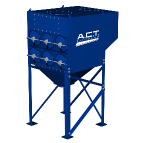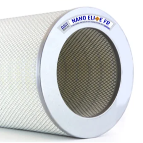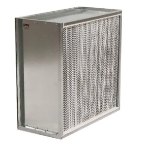
Adding a dust collector to your facility may be one of the best investments you can make.
Industrial dust collectors improve shop safety and cleanliness, help you meet compliance regulations, boost employee retention and happiness, reduce equipment maintenance costs, and deliver ongoing value year after year.
But here's something many facility managers overlook: dust collectors also offer significant end-of-year tax benefits for equipment purchase. As capital equipment purchases, dust collection systems typically qualify for valuable tax deductions when you buy and install them before December 31.
With the year winding down, now is the perfect time to explore how a dust collector can benefit both your operations and your bottom line. Here are three compelling reasons to consider a year-end purchase:1. Save on Your Taxes
If you've been thinking about purchasing a dust collector, acting before December 31 could unlock substantial tax savings.
Under Section 179 of the IRS tax code, businesses can deduct the full purchase price of qualifying equipment in the same year it's placed into service - rather than spreading those deductions over several years.
For 2025, businesses can deduct up to $1,250,000 in qualifying equipment purchases under Section 179. The deduction begins to phase out once your total equipment purchases exceed $3,130,000 for the year. Whether you purchase your dust collector outright or use equipment financing or eligible leases, Section 179 often applies when the system is placed in service by December 31.
Beyond Section 179, bonus depreciation also applies in 2025. Under the One Big Beautiful Bill Act (signed July 4, 2025), qualified property acquired and placed in service after January 19, 2025 generally qualifies for 100% bonus depreciation. For property placed in service January 1-19, 2025, the 40% rate applies under the prior phase-down. Taxpayers may elect 40% instead of 100% for the first tax year ending after January 19, 2025. These provisions can work together with Section 179 to maximize your potential tax savings.
Note: As of October 2025, businesses should confirm current bonus depreciation rates with their tax advisor and monitor IRS guidance as implementation details continue to develop.
How to Qualify for section 179 Before December 31
Taking advantage of year-end equipment tax deduction benefits is straightforward if you follow these key steps:
- Purchase or finance your equipment: Dust collection systems qualify as capital equipment purchases under Section 179. Whether you buy outright, finance, or lease, you can typically claim the deduction when IRS business-use requirements are met.
- Get it installed and operational before year-end: Your system must be more than just purchased - it needs to be installed and ready to use by December 31. "Placed in service" means the equipment is operational and available for its intended business purpose.
- Work with your tax advisor on filing: Your accountant will help you complete the necessary forms and determine the best combination of Section 179 and bonus depreciation for your situation.
2. Gain Access to Excess Inventory
One of the biggest challenges with year-end capital equipment purchase planning? Long lead times.
Many equipment suppliers quote 8 to 16 weeks for delivery, which makes it nearly impossible to take advantage of current-year tax benefits if you're starting your search in the fall.
At A.C.T. Dust Collectors, we've solved this problem by maintaining robust, Ready-to-Ship inventory year-round. We stock our most popular models and continuously replenish as systems sell. Many of our standard dust collectors are in stock and ready to ship within 1 week.
Are you adding a new laser or plasma cutting table this year but worried you won't find a compatible dust collector in time? We can help. Whether you're in metal fabrication, woodworking, pharmaceutical manufacturing, or one of the other dust-producing industries, we have systems designed for your specific application. And we have them in stock right now.
Our ready-to-ship products include standard-size dust collectors (brand new), OEM replacement filters, and top-mounted blowers ranging from 5HP to 40HP. This availability is crucial for businesses pursuing qualifying equipment purchases before the December 31 deadline.
3. Stay Safe and Healthy During Winter
During summer, many facilities enjoy natural ventilation by keeping doors and windows open. But as temperatures drop and winter sets in, those openings must close - and that's when indoor air quality can become a serious problem.
Without proper ventilation, airborne dust accumulates quickly. Fine particles from cutting, grinding, welding, and other processes circulate through your facility, creating health risks for employees and settling on equipment and products. Installing a dust collector - especially one with a return air system - addresses both problems at once.
A dust collection system with return air capability filters harmful particles from your workspace while recirculating heated air back into your facility. This means you maintain comfortable temperatures without exhausting expensive heated air outdoors, resulting in lower energy costs all winter long. Your employees work in a cleaner, healthier environment, and you save money on heating bills.
For more winter tips, see A.C.T.'s guide to keeping your factory warm while maintaining indoor air quality.
The timing couldn't be better: you can improve indoor air quality and protect your team while capturing tax savings on industrial equipment through Section 179. It's a win-win that addresses immediate operational needs and delivers long-term financial benefits.
Frequently Asked Questions
Does a dust collection system qualify for Section 179?
Yes, dust collectors typically qualify as capital equipment purchases under Section 179. They're tangible business equipment that meets IRS requirements when placed into service during the tax year.
Typically, both new and used systems can qualify, as long as the equipment is new to your business. To be certain your specific purchase qualifies and to understand any income limitations that might apply, check with your tax advisor.
What are the top cost savings from buying a dust collector this year?
The savings come from multiple sources.
First, there's the immediate Section 179 deduction - up to $1,250,000 for 2025. Second, you may qualify for bonus depreciation on top of that. Third, you'll reduce operational costs through lower energy bills (especially with return air systems), less equipment maintenance, and fewer filter replacements.
Finally, a dust collector supports OSHA and NFPA compliance efforts around air quality and combustible dust control. Your actual savings depend on your specific facts and circumstances - work with your tax advisor to model the potential impact.
What equipment purchases are eligible for end-of-year deductions?
Section 179 covers a wide range of depreciable business equipment - machinery, computers, office furniture, vehicles (with some restrictions), and manufacturing equipment like dust collectors. The key requirement is that the equipment must be used for business purposes and placed into service during the tax year. For complete details, your tax advisor can reference IRS Publication 946.
Can I finance or lease a dust collection system and still meet the deadline?
Often yes. Section 179 can apply to financed equipment and certain lease structures when properly structured and placed into service by December 31.
Many businesses prefer financing because it preserves working capital while potentially delivering tax benefits. From a regulatory perspective, installing a dust collector before the cold season also supports OSHA and NFPA best practices around workplace air quality and combustible dust control. For site-specific requirements and financing qualification, consult your tax professional and safety team.
Solutions for All of Your Industrial Dust Collection Needs
Dust collectors are qualifying equipment purchases under the IRS tax code when business-use and in-service rules are met.
A.C.T.’s team can help you plan the technical side - sizing, installation requirements, and system functionality - while you coordinate tax strategy with your advisor. We offer application guidance, drawings, layout support, product customization, and site visits to ensure the right system is selected and installed correctly the first time. Many of our customers benefit from on-site facility visits, where our team evaluates your space, discusses your needs, and develops a customized solution.
Ready to move forward? Explore our products, applications by industry, and ready-to-ship inventory to find the right fit for your needs. Then request a quote today to take advantage of Section 179 deductions before December 31.
Disclaimer: This article provides general information about tax deductions and is not intended as tax advice. Tax laws are complex and vary by business situation. Always consult with a qualified tax professional or CPA to determine how Section 179, bonus depreciation, and other tax provisions apply to your specific circumstances.



























%20Collectors%20Image.png?width=143&height=143&name=ADC%20(Ambient)%20Collectors%20Image.png)



























.png?width=240&height=91&name=ACT%20Dust%20Collectors%20Logo%20Solid%20White%202020%20(1).png)
.png?width=148&height=149&name=usa-manufactured-dust-collectors%20(1).png)